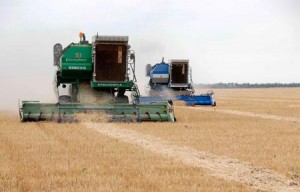 ASTANA – Kazakh grain exports for the 2013-2014 marketing year will reach 9 million tonnes, the country’s Ministry of Agriculture has said. Kazakhstan’s grain exports are still heading to traditional markets, but efforts are underway to reach new markets in China and Southeast Asia and to modernise grain holding and transport technologies to make the industry more profitable.
ASTANA – Kazakh grain exports for the 2013-2014 marketing year will reach 9 million tonnes, the country’s Ministry of Agriculture has said. Kazakhstan’s grain exports are still heading to traditional markets, but efforts are underway to reach new markets in China and Southeast Asia and to modernise grain holding and transport technologies to make the industry more profitable.
Due to a significant inflow of investment and technology to the grain industry, Kazakhstan has created a steady foundation for the production of grain over the last 10 years. Despite occasional lean years, grain production profitability in the past has remained around 52-65 percent at a cost of 15,000-18,000 tenge (US$82.39 to 19.87) per hectare, making the grain industry attractive over the long term.
The high quality of Kazakh wheat has contributed to the country’s positioning as one of the leading exporters of grain and flour. Kazakhstan is among the world’s top 10 suppliers of wheat and is a leader in flour exports. From 2008-2012, the average annual export of grain, including flour in grain equivalent, amounted to 8.2 million tonnes, an increase compared to the previous five-year period of 2.5 million tonnes or 42.6 percent. Aggregate currency earnings from grain and flour exports totalled more than $8.8 billion, more than doubling the 2003-2007 amount.
Traditional importers of Kazakh grain are Russia, Azerbaijan, Uzbekistan, Tajikistan, Iran, Kyrgyzstan, Turkey, Georgia, China, Sweden and Afghanistan. They account for more than 98.8 percent of exports.
Most of these traditional importers of Kazakh grain can’t produce it themselves in needed quantities, meaning the demand for Kazakh wheat there will remain high. In addition, the steady population growth in the countries of Central Asia will also stimulate demand for Kazakh wheat. In general, according to experts at the country’s KazAgro Holding, Kazakhstan’s grain industry is stable.
The Chinese market is also very promising for domestic grain producers. In 2013, according to statistics, 124,000 tonnes of grain was exported there, including 10,000 tonnes by the Food Corporation National Company. In 2014, exports to China are expected to increase to up to 30,000 tonnes. Kazakhstan plans to build a grain terminal at the Kazakh-Chinese border, which will increase export capacity and help provide an uninterrupted supply of Kazakh grain to China and Southeast Asian countries. Currently, grain is delivered mostly by railway. The Aktau seaport in the west of the country can handle only 500,000-600,000 tonnes of grain per year.
According to the International Grains Council, China’s annual grain import varies from 3 to 8 million tonnes. In connection with this, the increase of supply of Kazakh grain to China and transit through its territory to Southeast Asia is a strategic expansion of export markets for Kazakh grain.
In addition to reaching for new markets, efforts are being made to modernise the grain industry at home. The current problem of refinancing agricultural enterprises will be reduced through the programme of financial recovery. The growth of free monetary resources in grain companies will stimulate investment in modernising production and, consequently, will contribute to the growth of labour productivity. Thus, KazAgro Holding’s experts advise companies to invest in the construction and modernisation of granaries. This will allow them to sell grain during periods of higher prices and thereby increase their profitability.
In addition, the programme of investment subsidies launched in 2014 will allow them to compensate part of the costs of creating grain storage capacities and thereby accelerate returns on these projects. Separately, it should be noted that the devaluation of the national currency in February this year has also had a positive impact on the export-oriented grain industry.
According to a report by the U.S. Department of Agriculture, forecasts of wheat exports to Kazakhstan in the 2013-2014 marketing year, adjusted as of March 10, showed an increase of 0.2 million tonnes (to 7 million tonnes) compared with the previous marketing year (6.8 million tonnes). A significant increase was marked in Russia, where exports grew by 6.22 million tonnes to 17.5 million tonnes and Ukraine, with a growth of 2.8 million tonnes to 10 million tonnes.


